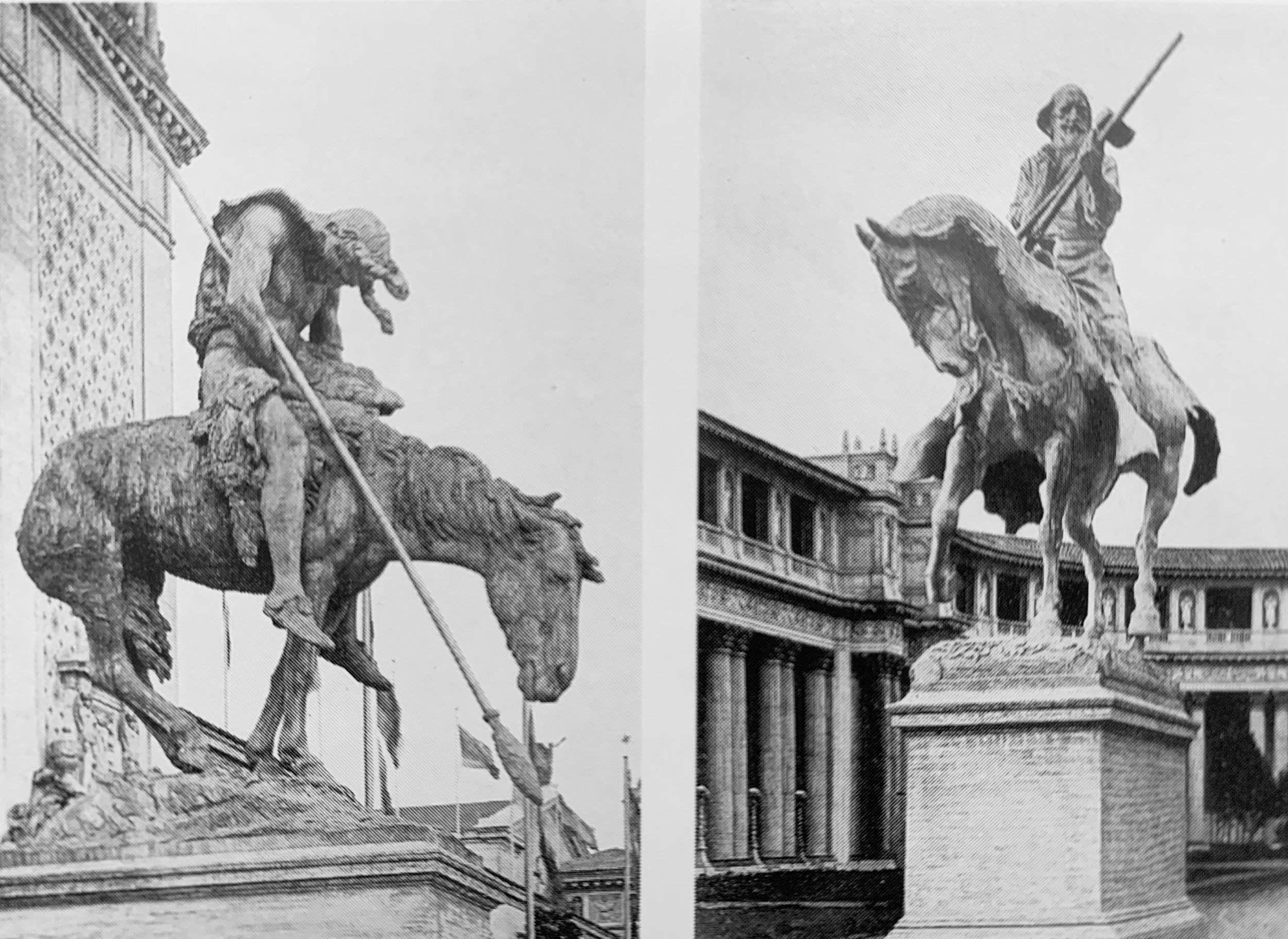Chapter 6
Toward Limitless Energy
An adequate supply of energy extracted from a growing hinterland is as necessary to a growing city as fresh water, and this San Francisco’s leaders early set out to acquire because of California’s dearth of good coal. Hydraulic mining led to innovations in hydroelectric energy still in use today, but the development of Southern California’s immense oil reserves also served city magnates such as Michael De Young. Tubes, wires, and railroads, like aqueducts, fueled the city’s imperial ambitions at the cost of the colonies from which the energy was taken such as the West’s felled forests and the dammed Hetch Hetchy Valley in Yosemite National Park. The Curies’ discovery of radium in 1898 opened the possibilities for a yet-unknown super-energy that would eliminate all limits to growth.
The American Pioneer, by Solon Borglum, was the companion to James Earle Fraser’s ultimately more famous The End of the Trail at the Panama-Pacific International Exposition of 1915. The paired statues represented relative racial energies against an imperial backdrop. Ben Macomber, The Jewel City, 1915.
Selected notes
For more information on all the materials cited see the further reading page.
1. Cf. Lane’s speech with that of Ronald Reagan quoted in the introduction: “The men of the Alamo call out encouragement to each other; a settler pushes west and sings a song, and the song echoes out forever and fills the unknowing air. It is the American sound: it is hopeful, big-hearted, idealistic-daring, decent, and fair. That’s our heritage, that’s our song. We sing it still.”
13. Unlike the Los Angeles Times publisher Harry Chandler, whose numerous corporate interests were listed in Walker’s Manual of California Securities and Directory of Directors, de Young’s name does not appear at all.
15. A government report stated that “there is probably no large business so inefficiently conducted as is that involved in the production of oil in California, notwithstanding the fact that mechanical conditions here seem to be more advanced and improved than in any other part of the world.” The abundance of oil contributed greatly to the industry’s wastefulness, recalling similar conditions on the Comstock Lode. Quam-Wickham, “Petroleocrats and Proletarians,” 128.
26. Ibid., 100-102. Among the companies on whose boards Drum sat were Sharon, Tevis, and Haggin estates; Bay Cities Water; Occidental Land and Improvement; Palace Hotel; Guanacevi and Santa Eulalia Mining; Pacific Portland Cement; Southport Land and Commercial; Real Estate and Development; City Land; Pacific Coast Oil; Associated Oil; Amalgamated Oil; Shreves Oil; Sterling Oil; Pacific Realty; Kern County Land; Yosemite Valley Railroad; and California Pacific Title Insurance.
31. Hall told the PG&E president A. F. Hockenbeamer on April 26, 19 1o, “I shielded your company and its controlling people from being known as the owners of the properties the City administration was after, and at a time when the knowledge of such ownership would have been used to injure your Company and them I have persisted and made over $100,000 for you.” The company settled with Hall three days later. William Hammond Hall papers, carton 10, folder 27, Sierra Ditch and Water Company file.
38. Santa Fe reached the bay by buying the San Francisco and San Joaquin Valley Railroad, which was also known as the “Valley Road” or the “Spreckels Road” since Claus Spreckels and his sons put up major financing for its construction. Spreckels bought 250 acres, or half, of Richmond’s town plat, Santa Fe officials the remainder.
47. Henry Adams to Henry Osborn Taylor, 17 January 1905, in Harold Dean Cater, ed., Henry Adams and His Friends (Boston: Houghton Mifflin, 1947), 558-59.
The Chronicle used the perennially popular mythology of the individual prospector of 1849 to encourage public investment in oil stocks during the California petroleum boom more than 50 years after the Gold Rush. San Francisco Chronicle, January 8, 1911.
Few of the Chronicle’s readers were aware that its publisher, Michael de Young, was also president of the California Petroleum Miners Association which diligently sought new markets for California’s overproduction of petroleum. San Francisco Chronicle, January 12,1916.
The Pelton wheel, an ingenious outcome of California mining engineering, was quickly adapted to electrical generation. Journal of Electricity, Power, and Gas, August 21, 1909.
An industry magazine exulted that Uncle Sam “Burns California Oil.” The U.S. Navy and navies of other nations provided a ready market for the state’s overproduction of petroleum. The Oil Book, July 11, 1910. Courtesy Bancroft Library.
The Curies’ discovery of they mysterious element radium promised infinite energy in the early 20th century. San Francisco Bulletin, March 8, 1903






